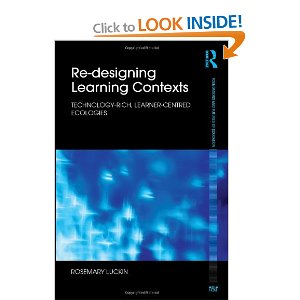Vanessa Pittard DfE, Richard Noss TEL Research Programme Director, BESA, Intellect, ALT, and Demos about research inspired technology enhanced learning to tackle challenges from teenagers’ energy consumption to social communication in a multimodal virtual environment for youngsters with Autism Spectrum Disorders. What the research says event at LKL now has a waiting list for places! Clearly people do want to talk.
-
Pages
-
Categories
Let’s talk about what the research says: Industry, Academia, Learning: 7 days to go
March 23, 2012 — Prof. Rose LuckinHeads in the Cloud
January 30, 2012 — Prof. Rose Luckin At a quick glance one might think that the title of this post means that I am thinking about the 2004 romantic drama with Charlize Theron and Penélope Cruz
At a quick glance one might think that the title of this post means that I am thinking about the 2004 romantic drama with Charlize Theron and Penélope Cruz
…and I do love films, as anyone who knows me will be aware.
However this post is about ‘Heads in the Cloud’ as opposed to ‘Head in the Clouds‘ and refers to the technological cloud that lets us connect with resources, people and applications from almost anywhere, without having to lug loads of technology around with us. Not that long ago, the idea of being able to access sophisticated computation and almost limitless information without needing to know where all this stuff is would have been nothing more than a romantic glint in the eyes of computer scientists and engineers. Now it is a reality: an important reality for learning. The implications of the cloud were the subject of a panel organised by Brightwave at the Learning Technologies exhibition.
When thinking about the panel it struck me that there are some useful things that research can tell us about how people think and learn that might help us make the best use of the cloud.
Firstly, technology driving learning closer to the workplace means that we can help learners to transfer and apply what they learn to their work. We know that learning through a variety of real world experiences can help people to use their learning flexibly and effectively. The cloud enables learning across a variety of these all important real world contexts.
Secondly, there are important generational differences in the way that people use technology in their everyday lives. Young people in particular are early adopters of new and emerging technologies. These technologies can increase engagement and empower people with a feeling of control. We can therefore use the cloud to recognise and benefit from the expectations and skills that younger people bring to learning and the workplace. The cloud can be used to support on demand learning for example.
And thirdly, theories of socially distributed cognition show us that people can learn effectively in groups and that people can offload some of their thinking through tools, such as technology, and through other people. The cloud can help us to bring people and technologies together to make the most of these collaborative learning opportunities that can help people to learn in this distributed manner.
The panel audience thought that cloud technologies could be used to create a knowledge environment that encourages sharing and that learning designers would need to focus upon continuous learning. However there were also concerns that it would be difficult to prove what knowledge had been acquired, which suggests that new forms of continuous assessment, and self-assessment, might also be needed.
So the cloud for learning is about multiple heads in the integrated and single cloud, working together to solve increasingly complex problems and learning whilst they do so, using the technology to capture evidence of that learning. This is not a romantic notion, rather it is an achievable and desirable vision.
Archives
- April 2019
- November 2017
- September 2017
- August 2017
- February 2017
- January 2017
- September 2016
- August 2016
- May 2016
- March 2016
- February 2016
- November 2015
- October 2015
- September 2015
- March 2015
- February 2015
- April 2013
- November 2012
- October 2012
- July 2012
- June 2012
- May 2012
- April 2012
- March 2012
- February 2012
- January 2012
Read more…
Knowldge illusion
Tweets by KnowldgillusionMay 2024 M T W T F S S 1 2 3 4 5 6 7 8 9 10 11 12 13 14 15 16 17 18 19 20 21 22 23 24 25 26 27 28 29 30 31 - academics AI A Levels arduino Artificial Intelligence Assessment Augmented Reality BBC Basic BBC Micro Cloud coding Computer Science economist intelligence unit educational transformation ELIZA Emerging Technology Energy Exams Feedback Film Formal Learning France French Future of Work games hack Hacking ICT industry Informal Learning Innov8 Innovation internet iPad Knowledge Language Learning Learners Learning Learning Transfer Mobile Phone Natural Language Processing Old Fashioned On Demand Learning parents Participatory Design Pedagogy Pop-11 Potential Programming Research Socially Distributed Cognition students Teachers technology Teenagers Tests TV Vygotsky

